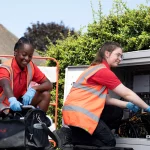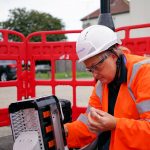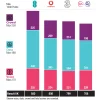Ofcom to Open UK 5G Mobile Auction of 26GHz and 40GHz Bands on 17th Sept

The telecoms regulator, Ofcom, has today revealed that they will begin accepting applications from network operators for their auction of the 26GHz and 40GHz millimetre wave (mmW) bands from 17th September 2025. The large chunk of radio spectrum will be used by mobile operators to deliver faster 5G data (broadband) services.
At present the major mobile providers (EE, O2 and VodafoneThree – Vodafone and Three UK) already have access to several 5G capable bands between 700MHz and 3.8GHz. Such frequencies reflect the same sort of mid-band radio spectrum that mobile network operators have been using since the advent of the first 3G and 4G networks.
The move to auction off 26GHz (25.1-27.5GHz) and 40GHz (40.5-43.5GHz) will complement those existing bands by providing lots of additional spectrum frequency, which means more data capacity for extremely fast speeds (e.g. multi-Gigabit). But such signals tend to be very weak and can’t cover a wider area without a much denser / more expensive network, which in practice means they’ll primarily be used for serving busy urban areas (shopping malls, airports etc. – “High Density Areas“) and fixed wireless broadband (FWA) links.
Advertisement
The good news is that after a long wait Ofcom has finally confirmed that they will start accepting applications from companies wishing to take part in the forthcoming spectrum auction from later this month – 17th September 2025. The first bidding is then expected to follow in October 2025 and we should thus have a good idea of who has won what by around the end of this year.
Any company wishing to take part in the auction must submit its application between 10:00am on 16th September 2025 and 4:00pm on 17th September 2025.
Ofcom Statement
Making mmWave spectrum available for new uses has the potential to deliver significant benefits to people and businesses in the UK.
This type of spectrum will enable services requiring very high capacity and speeds. It can play an important role in enabling mobile providers to meet current needs and future growth in demand for data – this means that it can help to improve capacity in busy places like train stations, busy urban areas, and sports and music venues where lots of people want to use their mobile phone at the same time.
As part of the auction launching today, we are awarding the spectrum in 68 “high-density” areas (that is, the towns and cities in the UK where we have identified high demand for mobile data).
We are already making spectrum in the 26 GHz band available to those who want a licence through our shared access licensing regime. This regime offers local area licences – for example this spectrum might be used to provide fixed wireless broadband in rural communities or to support automation in industrial sites, such as busy ports.
Details of the confirmed bidders, start date and results will be published on our website.
The regulator will be making the spectrum available in a clock auction (200MHz lots) with 15-year licences across 68 “high-density” areas (i.e. cities and select transport hubs). Interestingly, the UK is one of the first countries in Europe to award spectrum in the 40GHz band for mobile, although the 26GHz award is much more in keeping with the EU’s existing approach and many operators can already access it. Ofcom’s reserve prices for this could also be seen as modest when compared with other European auctions (£2m per 26GHz lot and £1m per 40GHz lot).
Luke Kehoe, Ookla’s European Industry Analyst, said: “While some EU member states (e.g., Germany, Sweden) have channelled mmWave into local or private licences, the UK’s single license covering all 68 high-density areas should make it easier for national neutral host and multi-venue operators to spread deployments across multiple sites, likely to raise take-up in the near-term (relative to purely local models). The UK’s approach aligns more closely with regimes in Spain (MNOs took ~1.8 GHz nationally in 2022), Croatia and Italy.”
Advertisement
However, the fact is that the use of mmW bands typically remains quite “hyper-local” (i.e. site-by-site rather than wide-area) in most countries, due to the aforementioned issues of limited coverage. Ofcom’s approach may have wider ambitions, but the economic realities of deploying in these bands will inevitably temper its reach. Not to mention any of the usual issues with limited support among end-user devices.
Mark is a professional technology writer, IT consultant and computer engineer from Dorset (England), he also founded ISPreview in 1999 and enjoys analysing the latest telecoms and broadband developments. Find me on X (Twitter), Mastodon, Facebook, BlueSky, Threads.net and Linkedin.
« BT Group Moves to Improve UK Video Streaming with New Delivery Network























































Useless apart from large open spaces like Wembley or NEC.
Networks need to first capitalize on 700-800 MHz so I can use my phone in a frickin coffee shop before venturing into Star Trek.
What a waste of time. Actually providing 5G outside major towns and cities would be more beneficial.
Extra capacity where there are more people what a ridiculous idea.
4G in North Norfolk would be nice.
There is 4g in North Norfolk but it is a bit patchy.
And Holt has 5g on Three (I was an early customer, near LoS to tall Three/ee mast off the Hempstead road; Voda O2 down on a shower mast down in a dip closer to town)
Basic, usable connectivity across the whole country would be a good start. What we have right now is completely unfit for purpose. 4G, 5G, whatever G – it all sucks. It’s terrible everywhere in every single way.
It really isn’t terrible everywhere. How many masts have Winchester refused planning permission?
We need one physical network with equally spread out towers and lots of mvnos.
Cue the conspiracy theorists…
Seriously though, I’ll welcome this and will be interested to see how well it works.